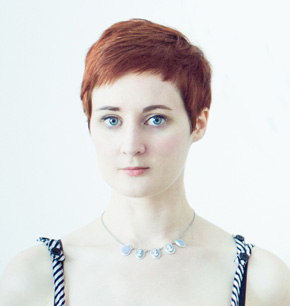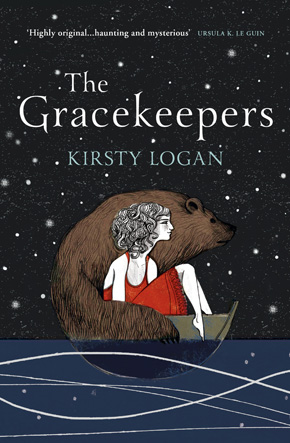Made-up worlds (and a worldie maid)
by Kirsty LoganIt’s a bit ridiculous to choose only ten examples of how world mythology has inspired popular culture, as the examples range into the thousands across books, films, TV, comics, games, music, fashion, and more. Any Top 10 can only be an intensely personal one, so that’s what I’ve chosen: ten of my personal favourites, taken from mythologies the world over.
1. Girl Meets Boy by Ali Smith
Part of Canongate’s series of retold myths, Girl Meets Boy is a modern-day interpretation of Ovid’s myth of gender-swapping Iphis. I wasn’t familiar with the myth before I read the book, and to be honest I’m still clueless about it beyond this novel. This is because Smith’s work always stands alone, even when it’s a retelling or reimagining. The story is beautiful and the prose is a joy to read. I particularly love the early chapters, where Smith gets inside a child’s experience of family so wonderfully.
2. Spartacus: Blood & Sand
This TV series is very loosely based on life of Thracian gladiator Spartacus, but as it focuses on his obscure early life leading up to the beginning of historical records, I’m including it here (also because the characters also make frequent references to the gods and myths of the time). Spartacus is a historical figure just as Robin Hood and Jesus are historical figures: we know they existed, but the details of their lives have been constructed into myth as they come to represent more than a mere human.
What I love about this programme is that it’s pure fantasy, and makes absolutely no attempt at historical accuracy. I’m no scholar of Ancient Rome, but even I can see that the costumes and language (real examples of dialogue from the programme: “dick-butt”, “shit-fuck”) are wildly inaccurate. The characters speak in odd syntax, leaving out pronouns: “What fever grips brain?” Even better, the sky and large sections of the set are obviously CGI, giving the whole thing a surreal tone.
3. Ondine
The selkie myth is one of my favourites, and it’s so underused in popular culture. Yes, this film has got Colin Farrell in it, but ignore him and look at the glorious County Cork landscape instead. Initially we’re invited to think that the mysterious and beautiful woman pulled up in Farrell’s fishing net is a selkie – a creature who can transform between seal and human – but as the narrative progresses, elements of the real world intrude: kidney transplants, deportation, and scary foreign gangsters. What I like is the way that it moves from a fantastical beginning to a more realistic conclusion, while many mythical stories do the opposite.
4. Fables by Bill Willingham
This long-running comic series began with the European fairytale characters of Snow White, Sleeping Beauty, Prince Charming and the Big Bad Wolf (or Bigby Wolf, as he’s known in the comic). As the series has progressed, Willingham has introduced fairytale characters from other countries – Russian Baba Yaga, Middle Eastern Sinbad – as well as characters from classic books – Pinocchio from Carlo Collodi’s tale, a winged monkey from L. Frank Baum’s Oz books, Frankenstein’s monster, and Shere Khan the tiger from Rudyard Kipling’s The Jungle Book – and even real-life characters like famous executioner Jack Ketch.
I’m a huge fan of this method of gleefully mishmashing characters from different sources. After all, where’s the fun in a simple retelling? I prefer this magpie approach.
5. Ash Mistry and the Savage Fortress by Sarwat Chadda
This Young Adult book trilogy takes the usual tropes of the reluctant hero, the timeless curse, and the damsel in distress and mixes them vividly with Indian mythology. There’s Prince Rama and Princess Sita, the death goddess Kali, and the demon king Ravana. Although they’re marketed as children’s books, they are some pretty gruesome moments (then again, as a child I loved gruesome books!)
6. Vikings
This gloriously-shot series is based on the legendary Viking Ragnarr Loðbrók and features references to many gods and myths: Odin, Thor, Freya, Freyr and Loki. Lagertha, a beautiful and tough-as-steel shieldmaiden, is one of my all-time favourite female characters, right up there with Daria and Scully. What I love about this series is that mythology is such an integral part of the characters’ lives, with visions of the gods seen as normal and vital.
7. The Leaping by Tom Fletcher
I love anything to do with the legend of the Wild Hunt: a spectral group of hunters, who may be the dead or the Fae, in mad pursuit across the skies. You’d better not get in the way of the Wild Hunt, or you’ll be spirited away to the land of the dead. It’s a truly European myth, with versions in England (my favourite English version is Cornwall’s ‘Devil’s Dandy Dogs’), Wales, France, Germany, Italy, Poland, Norway, Sweden and more. Ever since reading about the legend, I’ve wanted to write about it. Imagine my annoyance when I found that Fletcher had already done it so wonderfully and so creepily. This book has been preying on my mind ever since I read it.
8. Don’t Be Afraid of the Dark by Guillermo del Toro & Christopher Golden
This odd little book is presented as the illustrated journal of the protagonist of the film of the same name, and I like it because it ties in with my love of spin-off novels. I like spin-offs because it’s like reading the mythology of an imaginary world – a double invention, a layering of myth. Think of The Diary of Ellen Rimbauer (the diary of a character in Stephen King’s novel Rose Red), or The Diary of Laura Palmer (a fictional diary of the dead girl whose murder is investigated in Twin Peaks). Not surprisingly from this list, my favourite spin-offs are presented as diaries of the characters.
I include this book because it plays on a myth that we continue to tell our children as if it were true: the story of the Tooth Fairy, a tiny creature who creeps into your room at night to steal your teeth. We say that she only takes them after they’ve fallen out, but it’s no great stretch to think that she’ll get impatient. When you think about it, the Tooth Fairy tale is absolutely terrifying. What could she want with all those millions of teeth?
9. The Penelopiad by Margaret Atwood
Another from Canongate’s wonderful series of retold myths. While Homer’s Odyssey recounts the adventures of Odysseus, The Penelopiad focuses on Penelope, the wife he left behind. I doubt that Atwood has written a clumsy phrase in her life, and this book is a glory from beginning to end.
10, Maid Marian and Her Merry Men
Hands up if you were in love with Maid Marian in the 90s!
Sorry, had to stop typing there as I had both hands up. I was obsessed with this programme as a child – it was surreal, anachronistic (not that I knew that word when I was a child) and full of sneaky social commentary. I love the way it delved into English myth and upended it. And most importantly for small me, Maid Marian was strong, clever and always in charge. I still want to grow up to be just like her.
 Kirsty Logan is a writer, performer, literary editor, writing mentor and book reviewer. Her first book, The Rental Heart & Other Fairytales, won the Scott Prize and was longlisted for the Frank O’Connor International Short Story Award. She regularly performs her stories at events and festivals throughout the world. She lives in Glasgow with her fiancée and their rescue puppy. Her first novel The Gracekeepers, magical story of a floating circus and two young women in search of a home, is published as a Harvill Secker hardback and a Vintage Digital eBook. Read more.
Kirsty Logan is a writer, performer, literary editor, writing mentor and book reviewer. Her first book, The Rental Heart & Other Fairytales, won the Scott Prize and was longlisted for the Frank O’Connor International Short Story Award. She regularly performs her stories at events and festivals throughout the world. She lives in Glasgow with her fiancée and their rescue puppy. Her first novel The Gracekeepers, magical story of a floating circus and two young women in search of a home, is published as a Harvill Secker hardback and a Vintage Digital eBook. Read more.
kirstylogan.com
@kirstylogan
Author portrait © MonkeyTwizzle


